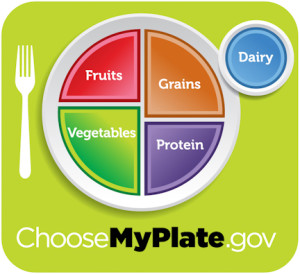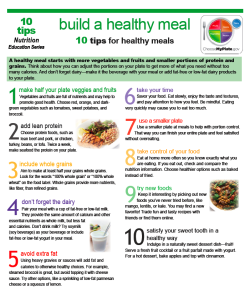 Laura Kenny, RD, Riverview Hospital
Laura Kenny, RD, Riverview Hospital
In early June, the United States Department of Agriculture (USDA) announced the discontinuation of the MyPyramid image and introduced the MyPlate program. This new image is designed to help people visualize a healthy, well-balanced meal that incorporates each of the food groups. Three of the most difficult aspects of nutrition are portion control, balanced eating and appropriate food choices. As a Registered Dietitian, I feel MyPlate addresses balanced eating; however, the visual leaves portion sizes and appropriate choices up to individual interpretation. In my professional opinion, below are some positives and negatives of the new image.
Positives:
- 50% of the plate is fruits and veggies which are naturally lower in calories and loaded with vitamins and minerals.
- Very simple and clear. MyPyramid received a lot of negative criticism for being overly complicated and difficult to understand. The MyPlate is significantly easier to comprehend.
Negatives:
While the following negatives may be addressed on the MyPlate website, they are not easily understood by looking at the image only. Many consumers may not have access to the website or have time to access this information.
- Portion size: How large is the plate? How high is the plate stacked? People that do not pay attention to serving size information may misinterpret the amount of food that should be on the plate.
- Frequency of eating: How many plates can I eat in one day?
- Types of foods chosen: MyPlate does not differentiate between starchy and non-starchy vegetables, whole grains, lean meat or low fat dairy. For example, there is a big nutritional difference between the following two meals: a hamburger and french fries with a strawberry milk shake and a grilled chicken sandwich with low fat cheese and a whole grain bun with broccoli and watermelon.
- Exercise: Unlike MyPyramid, no incorporation of exercise is emphasized.
- Lack of pictures: Only colors and words are used on the MyPlate image. Kids and individuals with limited reading ability may not benefit from the image. It may be beneficial to add a few pictures of appropriate foods into each of the sections.

Overall, the MyPlate image does provide a great starting point for balanced meal planning. More information needs to be provided to consumers about portions, sizes of plates and foods to choose for optimal health. In my opinion, utilizing MyPlate for balanced meal planning and MyPyramid for overall daily calorie and food group consumption may be the best format for nutrition education. If you were a fan of the MyPyramid program, do not worry as it will still be available on the www.choosemyplate.gov website for viewing and educational purposes.
